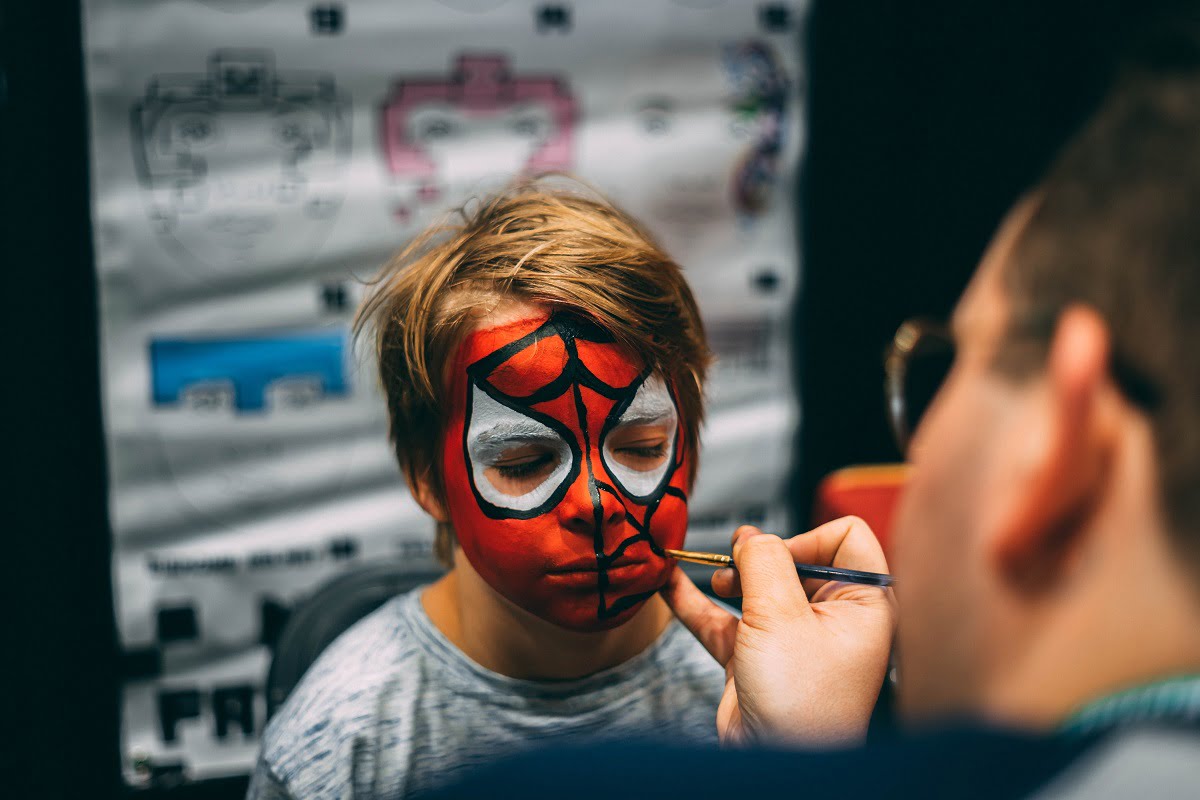Acrylic paints are popular when painting on canvas and for other arts and crafts projects.

So, can acrylic paint be used on skin? Although these paints can be washed off easily using just water and soap, they might not be the best option when it comes to certain applications, like painting on skin. Thus, most of the body paints for professionals or amateurs available in the market are free from acrylic paints.
Although acrylic face paint is not toxic, it can contain harmful chemicals because of which it might not be safe to use. On the other hand, washing off acrylic paint from your face or skin is another hassle you don’t want.
In this guide, we will go through why these paints are harmful to the skin and their viable alternatives. We will also discuss how to remove these paints safely and effectively.
So, without further ado, let’s dive in!
What Are The Ingredients In An Acrylic Paint?

A. Cobalt Pigment
This deep blue cobalt pigment came into origin during the 18th century and is more expensive than any other acrylic paint pigments. Paints containing cobalt pigment are mildly toxic and might lead to skin irritations, allergies, and asthma if inhaled. Ingesting the pigment can even lead to vomiting, nausea, and diarrhea.
B. Cadmium Pigment
Discovered over a century later than the cobalt pigment, this pigment is used to create yellows, browns, and vibrant red paints. Cadmium being a rare pigment, isn’t seen in many paints nowadays. That’s good because over-exposure to it leads to severe health issues and it’s also carcinogenic.
C. Chromium Pigment
Chromium pigment primarily goes into green acrylic colors and can cause havoc in the form of allergic reactions and dermatitis. Any contact with this pigment makes the skin red, itchy, and inflamed.
D. Manganese Pigment
Manganese is found in foods like leaves and nuts, but the pigments used in acrylic colors are actually synthetic. Like other pigments, it’s toxic and can cause severe reactions on the skin.
Is Acrylic Paint Safe To Apply On Skin?
There’s been an ongoing debate if acrylic paints are safe to apply on skin or not, where one group believes it is safe, while others claim that it’s not. But we’d say that acrylic paints shouldn’t be applied on the skin.
The ingredients in acrylic paints aren’t pharmaceutical-grade ones, so there’s a considerable risk of causing skin redness, irritations, itching, and damage. Although there are products that are made especially for skin, these should also be cleaned and washed off quickly.
Here are some of the disadvantages of applying acrylic paint to the skin:
A. Toxicity
Acrylic paint is not toxic as a whole, but some of its ingredients aren’t safe to inhale or apply to your body. So, while using these paints, always wear safety goggles and a mask or respirator.
The levels of toxicity of an acrylic paint varies on gender, age, and how one uses them.
B. Hardens When Dry
Acrylic paints harden over time, owing to the presence of certain ingredients in them. So, it can be used for painting on a canvas or walls, but it’s not ideal for the skin.
C. Difficult To Remove
If you fail to remove acrylic paint off your skin quickly, it begins to dry and harden, making removal much more difficult. And peeling off the paint becomes very painful, so it's best to use warm soapy water or rubbing alcohol to get rid of it.
Is Acrylic Paint Safe To Apply On Your Face?
Face skin is the most sensitive skin of your body, so using acrylics on it is not advised at all. However, some might ignore these warnings and go on to color their face, and it might not affect the skin as such. But, you might put your health at risk by using these colors. An allergic reaction is quite unpleasant and painful!
Some have found a way to use acrylic paint with moisturizers or vegetable oil to make it less toxic, but it would be best if you go for non-toxic options available nowadays. Many of these are ideal for face painting, which you might be looking for, especially at children’s parties. These paints are easier to remove and safe to use on your hands, face, and the rest of your body.
Is Acrylic Paint Safe To Apply On Your Hands?
Avoid applying acrylic paints to parts of your body, including your hands. It not only causes irritation or potential skin damage, but children might also lick some of it, leading to poisoning, stomach distress, and even bleeding. So, make sure to keep these paints away from the reach of your children.
If your kid has swallowed some paint by mistake, wash their hands immediately and make them drink a lot of water. If you are concerned about them consuming a lot of paint, rinse their mouth with salt water, and take them to your doctor immediately. Also, brush their mouth and teeth to get rid of the paint.

Which Type Of Colors Are Safe For Face And Body Art?
There are many skin-friendly paints available on the market, but the ones worth considering are as follows:
A. Water-Based Paint
Water-based paints are probably the safest bet when painting the human body and face. After all, most of these paints available on the market today have to comply with a strict set of guidelines.
They are a great option for kids because these are non-toxic and highly washable paints.
You can use several types of equipment or tool to apply these paints, be it an airbrush, paintbrush, or sponge. The only downside is that they’re susceptible to cracking and rub off easily. And they are not ideal for use in a professional setup like a modeling event.
B. Metallic Body Paint
Another viable alternative for acrylic paints would be metallic body paints. Have you seen the street performers who look like silver or golden statues? These people use this type of paint to achieve a shiny, glossy appearance, mixed with a special liquid, giving them the appearance of a statue.
Be cautious while applying these paints as they might cause skin irritation due to the presence of the metal powder in them. And these don’t come off very easily compared to water-based paint. So, it’s best to stay away from these paints unless your performance depends on them.
C. Alcohol-Based Paint
Alcohol-based paint is primarily used for making airbrush tattoos or special effect applications. As these paints are water-resistant, they are best used in sunny and hot areas or for underwater body painting. They do not easily peel or crack.
That said, alcohol-based paints aren’t rub-proof and come off easily when touched, so be careful. Nevertheless, if this paint is left to dry, cleaning it might take some effort. You will need some rubbing alcohol and wait a day to get the color off your skin.
D. Latex Paint
Liquid latex or latex is also used as skin paint and is an ideal option for cosplayers, as it is less expensive than custom costume designs. Unlike other body paints, they won’t leave any residue on your body. Here are a few things to consider before using latex body paint.
To begin, check if you’re allergic to latex or not. You don't want any redness or skin irritation after applying latex body paint. Apart from that, refrain from using it in extreme heat to avoid the risk of getting heatstroke. Latex paints block the tiny holes on our skin and prevent it from perspiring. Also, keep these away from areas that are irritated or damaged.
Latex sticks to your skin like wax, so shave the body part before applying, otherwise, it will pull the hair when you remove it.
E. Henna
Henna is more of a traditional and plant-based body paint on the list of alternatives. This paint is extracted from plant dye and turns brown and ultimately red when applied.
These are quite common in Asian countries as well as coastal cities of Africa and are usable in several events. For example, in coastal cities of Africa, this is used as body paint for women about to get married. Women in these parts also use this paint as skin decor. And being made of plant dye, it’s completely safe for adults and their kids.
Moreover, its removal is not strenuous; you can rub a scrub gently over the paint to get it off. But stay away from black henna as it contains additional chemicals that might cause an allergic and ugly reaction on your skin.
F. Commercial Body Paints
Companies like Starlight produce body paints in masses for everyone to use. These paints are generally available in containers or spray bottles, contain no percentage of latex, and therefore, aren’t toxic. The company has complied with established guidelines and rules regarding the ingredients used, making it trustworthy and reliable. You can test these paints to check if they work well on you.
G. Markers
These aren’t those everyday markers you use in schools, college, offices, or anywhere else. Some companies have come up with special body painting markers that are only meant for body painting. So, it’s considered a non-toxic acrylic paint and safe to use on adults and children.
Although, some body markers are made only for a particular body part and can be dangerous if applied anywhere else. The companies generally mention these disclaimers on their product labels, so check them before use.
All the paint types mentioned above are safe for human skin and will most likely not cause irritation. But, it’s essential to apply them on a small part of your skin first as a patch test. It’s the best way to ensure the body paint works for you.
Step-By-Step Procedure To Paint Body And Face
A. Step 1: Get Your Tools Ready
Before you sit down to paint the body, prepare all the tools needed for the first body painting gig, which include:
- Body paint and face paint kits
- Brush or sponge
- Water
- Mirror
- Wet baby wipes or towel
- Spray bottle
- Stencils
Use thin, round tip brushes for making more minor details and awide brushes for wider ones. You must keep at least three different types of brushes with you, each for black, white, and color paint. Having brushes dedicated to different colors prevents them from getting mixed.
Besides, get a plastic cup for water, which needs to be mixed with paints, and wash the brushes once done. Any sized plastic cup will work wonders. Moreover, keeping a few washcloths to wipe your brushes is essential. Purchase cheap ones if you're painting regularly.
Choosing body paint that suits your body the best is probably most important. Note that these paints must be of cosmetic grade, suit your skin tones perfectly, and shouldn’t cause any harm to your skin.
B. Step 2: Prepare Your Skin
To begin, decide how you would like to have your face painted. If you’re not sure about it, ask the professional makeup artist to show some face painting designs for you to choose from. Once you’ve decided which one to go for, check for any residues or oils on your skin. If necessary, apply a moisturizer to your face to help the paint adhere to your skin.
C. Step 3: Paint Your Skin
Start with adding the design base using a sponge. For that, dip the sponge tip into the water. Don’t soak the sponge thoroughly into the water as you need only a few water drops on it. Dip the wet corner of the sponge into the color you’ll paint your skin with and move it in circular motions to get the paint on it. Dab the sponge gently on your face to apply the color.
If you need a more vibrant color, soak the sponge even more in water and then paint. To get a more intricate design, you’d need to add another layer of color to the base. Select a color that goes well with the base, and use another sponge for further application. Make sure that both colors contrast each other well for your design to stand out.
For example, if you’re painting a butterfly and the base of its wings is purple, use blue rather than yellow. Use the dry section of the sponge to blend both the colors together.
Keep the paint to dry for a few minutes, and touch it with your fingertip to ensure it has dried well. If the paint comes off on your finger, keep it like that for a few more minutes, and once it's completely dried, continue painting.
Now, take out a thin brush to add more intricacy to the design. For that, dip the brush into the water, but don’t make it dripping wet. Make light strokes for more minor details while making thicker lines; use the flat side of the brush. In case the brush stroke goes out of the way, or you’ve made some error in its design, use the baby wipe to clear it out.
D. Step 4: Finish Up
Once the design is complete, wash your hands well using water and soap, especially around the cuticles and nails. The longer you wait to wash off the paint, the harder it is to remove.

Does Acrylic Paint Wash Off Skin?
Acrylic paint dries quickly and coats evenly, but it can be strenuous to wash it off your flexible skin if it hardens up or you’ve made a mess. However, your skin is non-permeable and oily so the paint won’t harden up soon. Here are a few methods to get rid of your body paint.
A. Method 1: Using Water And Soap
Step 1
If the paint hasn't hardened yet, treat the area right away.
The paint becomes much more difficult to remove as it dries and hardens. So, rinse the affected area with warm water. The heat of the water loosens the paint that has begun to dry and should wash away naturally. Washing the skin weakens the hold of paint as the skin gets slippery.
Step 2
Now mix a liquid detergent or hand soap with water until it lathers. Wash the painted area thoroughly by applying a firm pressure using a damp cloth or hand.
Traditional washing soaps or dish soaps are effective in this respect as they contain certain abrasive compounds and elements which wash off the dried-on stains.
Step 3
If a single application of soap and water has worked wonders and cleaned off your paint, it’s time to call it a day. Otherwise, you will need to repeat the entire process until the paint fades and washes away. You can even use a scrubber if mere hand pressure isn’t working well.
B. Method 2: Scrubbing With Baby Oil
Step 1
Wash the painted area with warm water mixed with liquid detergent or soap to loosen the paint and lather it. Try to get most of the acrylic paints off using water and soap, then dry the area before applying baby oil.
Because of the repellent relationship between oils and water, the baby oil won’t stick to the paint. It is the reason you should dry the area well using a towel.
Step 2
Squeeze out a few drops of oil onto the area and gently massage it using your hands. If the stain is very stubborn, you can use a sponge or cotton ball to get rid of the paint. Baby oils contain specific compounds that can break and dissolve the dried-on oil and acrylic-based paints.
Also, these oils are gentler on your skin than paint removers that contain harsh chemicals as their primary agents.
Step 3
In this step, you will rinse the loosened-up paint using warm water. If it cleans up your skin, you take the day off, or you will need to apply baby oils to get rid of the remaining stains.
An added benefit of using baby oils is that it leaves your skin feeling moisturized and smooth.
C. Method 3: Using Rubbing Alcohol
Step 1
Similar to the previous method, firstly, you’ll need to wash off as much of the paint using a mixture of warm water and detergent. Dry off the surface completely to ensure the alcohol isn’t diluted by the water.
Step 2
Take a large cotton ball swab or a washcloth and dip it into a portion of standard rubbing alcohol. Alcohol is a solvent for acrylic paint, so the paint starts breaking up as soon as alcohol is applied to the skin.
Pure rubbing alcohol is one of the most widely recommended means of removing acrylic paint from various surfaces.
Keep on rubbing the paint spot using a cotton ball or washcloth for it to get wet while providing alcohol the time to start acting on it. Make small and circular strokes on the spot to get the paint out of the skin surface. Wash off if all the face paint has come off, or continue scrubbing the area until it's clear.

Can You Put Acrylic Paint On Your Face Final Words
That’s all we had to tell you about whether acrylic paints can be put on the skin or not!
Acrylic is a popular painting medium, and with so many different designs and techniques available, the last thing you need to worry about is whether the paints are harmful to your skin. Also, since it’s so versatile, you can turn acrylic paint into face paint specifically designed for your skin. Here are a few tips for using these acrylic paints.
Make sure you’re reading all the labels on the product to understand what it contains and whether it might harm your skin or not. Never bring the paint too close to your eyes, mouth, or nose, and clean off any spills on the skin right away.
We hope you enjoy using these. Signing off with best wishes!
